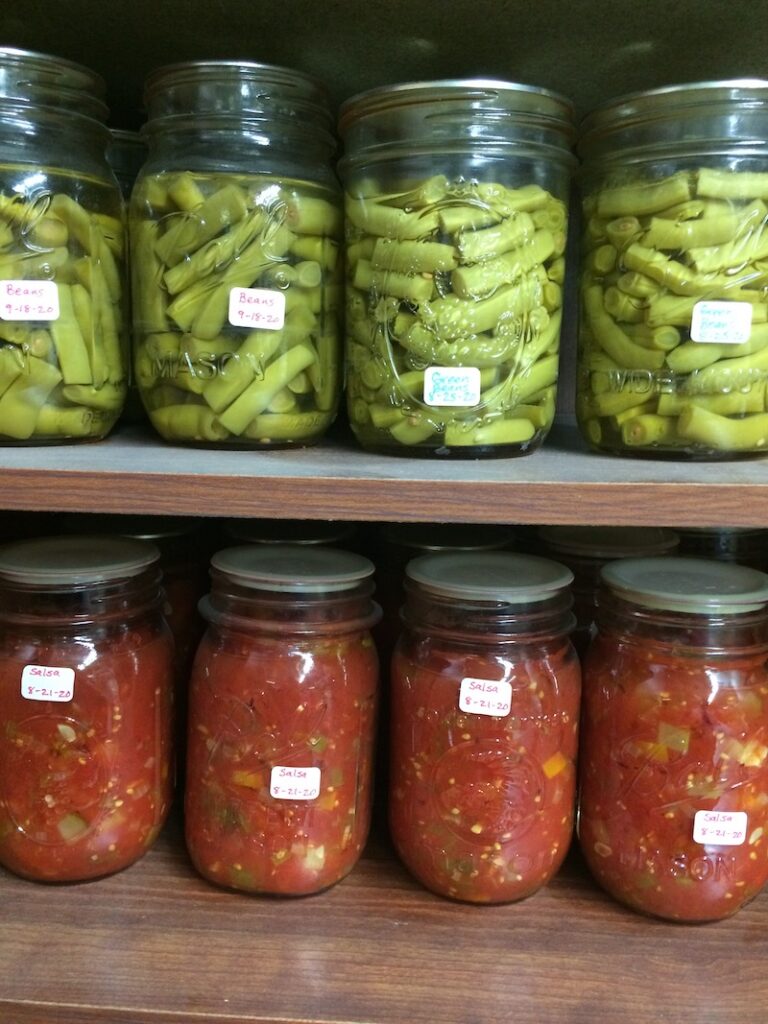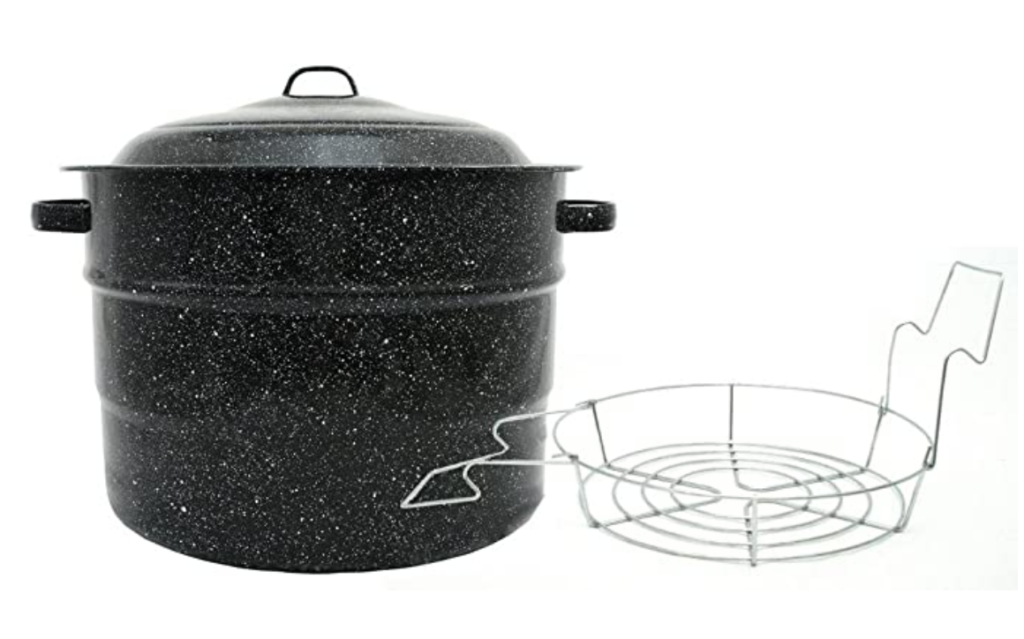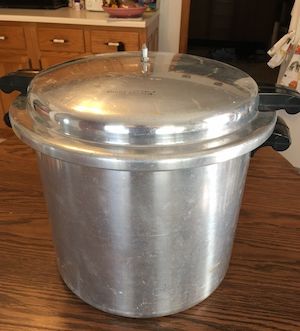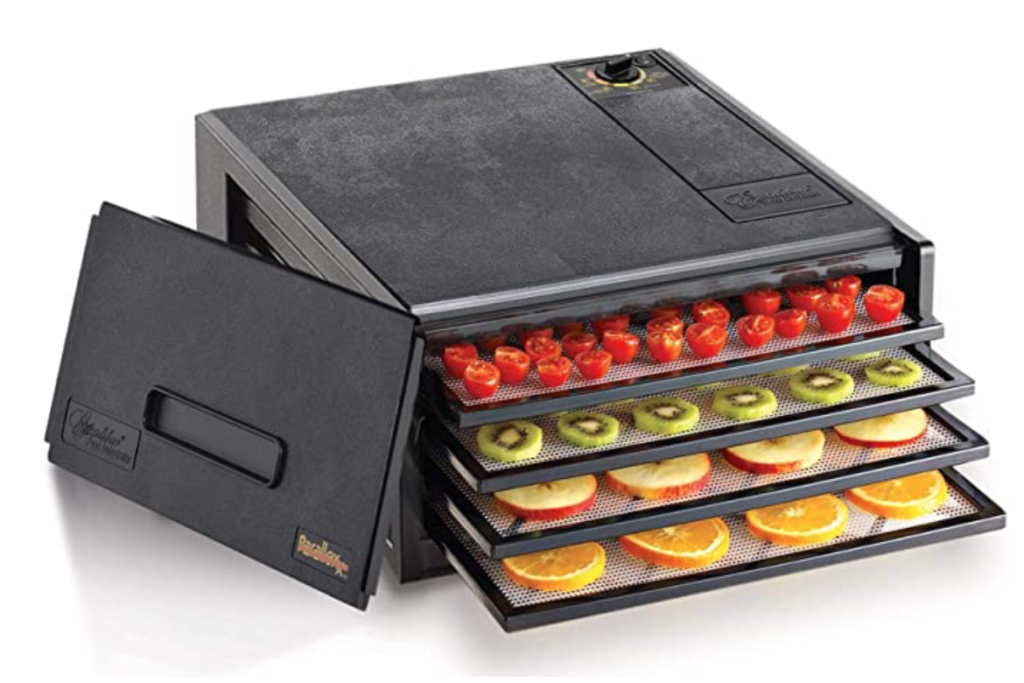This post contains some affiliate links.

Our approach to long-term food storage is two-pronged. The more active prong is improved sustainability — growing new food each year. Stored food eventually runs out. The only sustainable long-term food solution is to make new food.
That said, our less-active prong is to store bulk foods that we do not grow, like wheat and rice. These are intended to help stretch what our current gardens’ produce — which is not enough to live on alone at the moment. The other part of this second prong is having a fair pantry of grocery store foods — cans, boxes, bottles, etc. — to tide is over during a short-term isolation and to provide some variety during a long-term even when we’re cooking more with our bulk supplies.
Gardening With Long-Term in Mind
Seeing our gardens as a long-term food source guides what we grow. Generally, we grow what will keep well, time-shifting our harvest for eating during the winter. For the past many years, I’ve been working on making the Native-American companion planting — The Three Sisters — do well in my location. The hard-kernel corn (not a sweet corn) is a carb. The pole beans are a protein. The squash is a vitamin supplement. Those simple foods, while not exciting in the culinary sense, did sustain Native Americans for many centuries. I like being sustained.
We devote only a little space to ephemerals like lettuce and radishes, preferring crops that can be stored. We grow root crops such as carrots, beets, potatoes, and turnips as they keep fairly well in the right conditions. Onions and garlic keep well once dried off. Root crops can be kept “fresh” in the coolness of a root cellar.
Preserving Perishables
Some of our produce, like green beans, apples, and raspberries have a relatively short shelf life as “fresh” but can be preserved for later. We employ a variety of preservation techniques for the harvest of our gardens.

Hot Water Bath Canning — We make salsa out of our tomatoes, onions, peppers, and zucchini (as a filler). We also can just tomatoes and tomato juice. We slice up and can our pears and apples as just plain apples or pie filling. Cucumbers become pickles. We have canned up jams too, though we have about a hundred-year supply of jam already, so not so much of that lately. Our old canner actually had a hole wear through the bottom and had to buy a new one.

Pressure Canning — Low-acid or low-sugar foods like green beans and beets must be pressure canned. When the green beans kick in during the summer, we can’t eat them all. We save them up for a canning session’s worth and put them away for winter. Usually, the flock has a few “retirees” in the fall, so we can up some chicken meat for winter meals.
Dry Storage — Shelled corn and dried beans are kept in mesh bags or, sometimes vacuum-sealed in quart jars. Hot peppers get strung up and allowed to dry for storage. During the very low humidity conditions of winter, dry storage in room air has been sufficient. Keeping things dry enough during the humidity of summer is more of a challenge.

Root Cellar — Actually, it’s our garage. It’s a concrete-walled space that is mostly earth-sheltered. It stays moderately cool in summer and is our ‘drive-in fridge’ in winter, hovering around 35°. There, we store the garden’s squash, pumpkins, and some apples. Root crops are stored in a big bucket of sand. They stay good throughout the winter. Onions and garlic are kept dry and cool there too.
Fermenting — We grow cabbages, some of which get prepared into meals during autumn, but most gets turned into sauerkraut and stored in jars for winter consumption. The sauerkraut sometimes gets enhanced with carrot shavings and/or onions, for fun.

Dehydrating — As long as we’ve got grid power, we use our little Excalibur dehydrator to dry apple bits for winter cooking. We dehydrate eggs during the heavy-laying days of summer to compensate for the egg scarcity during the autumn molt and low-production winter. We also make fruit leather from our berries, saving them up in the freezer until there’s enough for a batch.
Mylar Bags — Thus far, the mylar bags and oxygen absorbers have been more for purchased bulk foods like the wheat berries. It is nice to have some longer-term foods protected for farther down the road, if need be.
An Eye Toward Long-Term
We also harvest seeds to ensure that we’ll have food next year too. By saving the seeds from things that did well in our garden year after year, we are (little by little) improving our harvests. Whatever grew well in our location, we want more of that and save those seeds. Whatever did poorly, we don’t need to devote space to that next year.
Long-Term food needs to look beyond storing purchased foods. If you can’t buy replacements, storage will eventually run out.
What do you do to preserve your harvest for later consumption?

Nice writeup Mic. I do all of that except the root cellar. My garage is wood and uninsulated. It’s great for keeping frozen things in the winter but far too cold for fruit and veggies. Even cases of water freeze solid after awhile.
I’ve been dehydrating for years but I finally broke down and bought an Excalibur last year and it caused me to go overboard again. The same with my All American canner I bought last year as well, they’re so fun I’m like a kid in the candy store.
I don’t do a lot of fermenting but I make a little sauerkraut and pickled vegetables every now and then. I was making a lot of kombucha a couple of years ago but stopped when my wife got burned out on it and we started wasting too much of it.
I was going to try sourdough bread but killed the starter by waiting too long. It died in the refrigerator.
Good Morning Mic, I have to say I am not a fan of canning. While excellent it depends way too much on a ready supply of disposable lids or rubber gaskets. Maybe tin cans if you go the LDS route. Some limited and risky re-use of disposables but food poisoning is already expensive Today with a ER visit.
I prefer dehydration, growing dry storage foods like beans, fermentation-Kimchee, root cellar.
Also given that spring has been known as the “Starving Season” long before grocery stores flying in foods from South America etc. I’ve been working on winter green house crops like beans, potatoes and bok choy. The Vitamin C in potatoes and bok choy seems pretty critical in staying healthy. Scurvy is a nasty disease.
Small livestock is critical as fats are a real issue in storage foods. Chickens and domestic rabbits are excellent. Rabbit starvation due to lack of fats is a WILD Hare Issue Not a domestic well fed rabbit issue.
Calories and protein are important so are essential fats and vitamins.
Anybody thinking about Salt? Unless you live near an ocean it’s hard to get after the stores close.
Hi Michael,
Not sure I quite followed you in the first paragraph. If canning is questionable due to reliance on one-use lids, why would canning in tin cans be better? That said, lids can be quite cheap and don’t take up much space, so you can have several years’ worth stashed. And, we get several uses out of each lid. They’re hardly use-once-and-discard. For pressure canning, we always use new lids. If the lid looks good after one use in hot-water canning, we have used them a second time — though always with a suspicious eye, checking them occasionally. Tattlers are okay and very reusable. The gaskets are said to be good for 10 uses. There again, we monitor them to watch for failed seals. Boxes of tattler gaskets take up even less space. It’s easy and fairly cheap to have a good supply of those.
I might guess that the risk of food poisoning is your primary objection to canning, more than the dependence on factory-produced components.
You’re right that dry stored goods like grains and beans are much simpler. I prefer that too, where applicable. Small livestock does seem like a vital component of homegrown foods. It’s hard to get around the nutritional value of meats and fats.
Salt is a problem for us who do not live on the ocean. It would be a serious commodity for trade if the grid were down long term, just as it was before refrigeration.
We’ll all need to figure out a way to live through the “Hunger Season” if things get back to the old agricultural cycle.